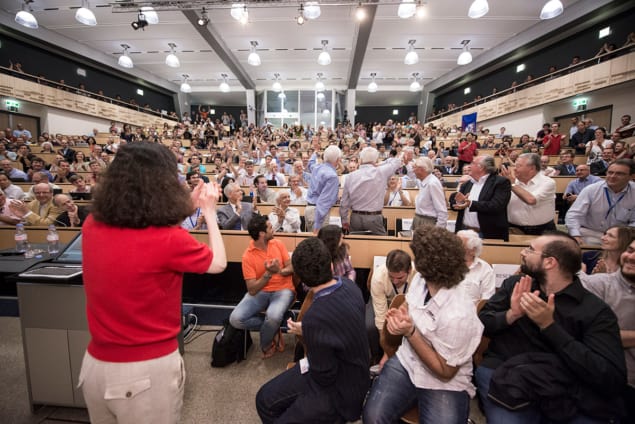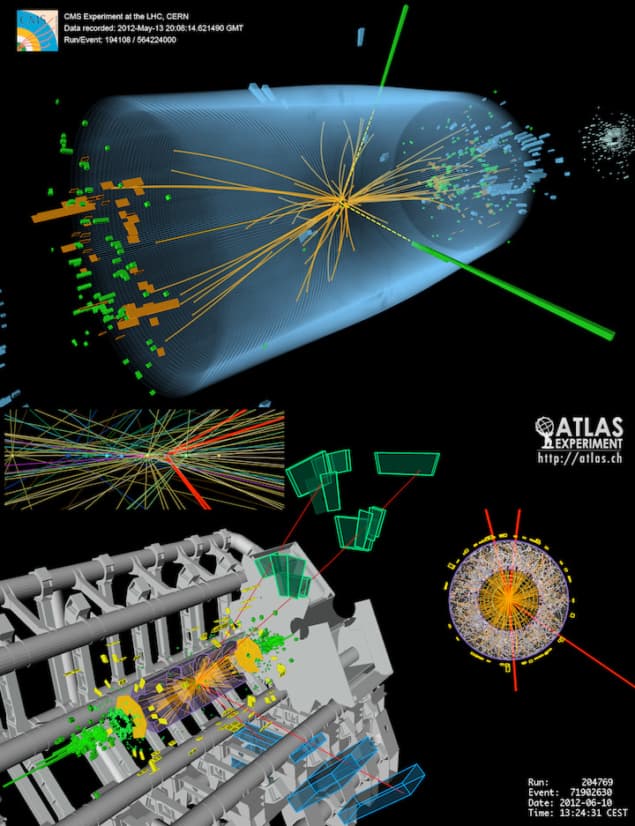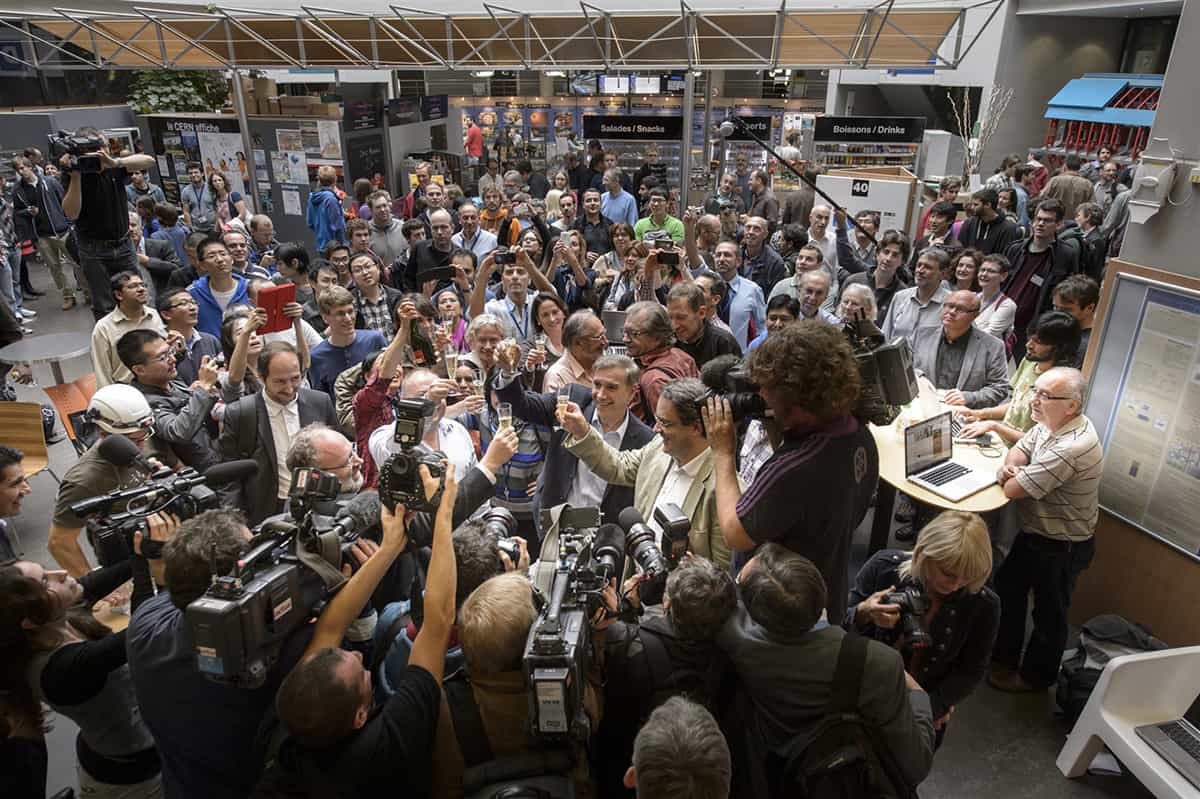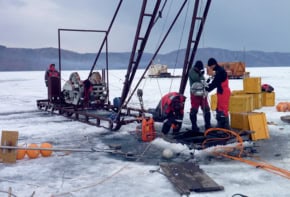Achintya Rao recollects the momentous day 10 years ago when CERN announced it had discovered the Higgs boson

It was around a quarter past midnight on 4 July 2012, and I was sprinting to catch the last tram of the night home from CERN, the particle-physics laboratory in Geneva, Switzerland. I had just spent the last few hours helping to put the finishing touches on an important article (one that was ultimately translated into 20 languages) that would soon appear on the website of the Compact Muon Solenoid (CMS) experiment, one of the two general-purpose particle detectors at the Large Hadron Collider (LHC).
As I rushed to the tram stop, I noticed the queue that had begun to form outside CERN’s main auditorium. A few enterprising students were asleep by the entrance, keen to get one of the handful of available seats for the seminar that was to begin at 9.00 a.m. that day. Outside, the night was clear and quiet, but in just a few hours the laboratory would be abuzz with crowds and excitement. Because today was the day that the CMS and ATLAS collaborations would announce the discovery of the Higgs boson.
An early Christmas present?
Anticipation had been building for months and wasn’t limited to scientific circles. On 13 December 2011, at a special end-of-year seminar at CERN, ATLAS spokesperson Fabiola Gianotti, together with Guido Tonelli, her CMS counterpart, had presented the latest results from each collaboration’s search for the Higgs boson. For years, CERN’s seminars had been publicly broadcast, as a way to serve the wider community of high-energy physicists, both experimentalists and theorists. Despite this being a highly technical seminar, it attracted an extremely wide audience of tens of thousands of viewers – including many journalists – from around the world. Indeed, the CERN IT team was forced to allocate additional resources to its streaming service, both for that seminar and to prepare for the attention that any potential discovery announcement might attract one day.
By late 2011, the LHC had delivered sufficient collisions to ATLAS and CMS at an energy of 7 TeV to allow the collaborations to start hunting through the range of masses where the particle had been predicted to be found. As she spoke, Gianotti could barely hide her excitement when she showed the slide with the regions that ATLAS had excluded in the search for the Higgs boson. The regions that had not been ruled out, however, continued to intrigue.
A slight excess was present at around 125 GeV, with a significance of 2.8σ – significantly less than the 5σ required to claim discovery, but enough to give everyone watching hope that the last piece of the Standard Model of particle physics was within our grasp. When he followed, Tonelli showed a similar excess in the CMS data. Although both collaborations cautioned that more data were needed to determine if the excess was indeed associated with the signal from a real particle, rather than the result of mere background fluctuations, it seemed as though Christmas had come early.
More data, however, were not immediately forthcoming. The LHC is a fantastically complex piece of machinery and requires regular maintenance. The behemoth was on its annual hibernation slumber at the time of the December seminar, and would only awaken in the spring. In February 2012 CERN announced that the accelerator would collide protons at an energy of 8 TeV that year, an increase of 0.5 TeV per beam; it would also deliver more collisions per second. ATLAS and CMS both began receiving collisions on 5 April, as the LHC broke its own record for the highest-energy particle collisions by an accelerator. But what these new data were to reveal would remain hidden for a little while longer.
Double-blind data, under wraps
Looking for a new particle at a particle accelerator involves some detective work. When two protons collide in the LHC, they may produce any of a number of heavy particles, including previously unseen entities such as the Higgs boson. But since these particles are unstable, they transform – or “decay” – almost instantaneously into lighter and more stable particles such as leptons (electrons or muons) and hadrons (e.g. neutrons). These decay products propagate through particle detectors such as ATLAS and CMS, leaving traces and energy deposits in the various layers that make up these instruments.
By aggregating the final states of the tracks and energies of the particles that billions upon billions of collision event leave in the detectors, physicists can work backwards to determine what the original particle produced in the collisions was. The data are typically examined using histograms of the masses of the decay products, with significant bumps in the data corresponding to the presence of a specific particle.

In the case of the search for the Higgs boson, the mass histograms for pairs of photons and for four leptons were critical. That is, the searches focused on cases in which a Higgs boson, after being produced, would transform into two photons; or cases in which it would transform into two Z bosons, with both transforming into pairs of leptons to give four leptons in the final state. Both ATLAS and CMS had reported a slight excess in these two datasets at the December 2011 seminar, and so took certain precautions when analysing the data being recorded in 2012.
To prevent subconscious biases from optimizing the analyses to augment the signals that had been seen in 2011, the collaborations did a “blind” analysis. Data in the mass regions that had been ruled out previously were used to optimize the analyses of the overall data, while the regions that had not been ruled out remained behind metaphorical blinds. Because the Higgs boson’s presence had been excluded in large mass ranges, there was no risk in using these data to minimize noise, and fine-tune the data processing. The mass regions of interest would not be analysed until the scientists were satisfied with their analysis methods. The analysis would then be extended to the entire dataset as part of the “unblinding” process.
Things moved swiftly on the accelerator’s part and in a few weeks the LHC had delivered more data than it had in all of 2011. On 15 June, just over two months after the 8 TeV data first started to arrive, experimental physicist Mingming Yang stood in front of her CMS colleagues, ready to present the results of the unblinding of the “two-photon” data. “With this, my heart is beating even faster,” she said, as she asked those of us gathered to brace ourselves for the next 15 minutes.
This was the first time those outside of the “Higgs to two photons” working group would see the results. Yang showed that the excess in the two-photon channel, from the combination of data from 2011 and 2012, had breached 4σ. Less than two weeks later, on 28 June, André David, who is today a section leader in CMS, presented the results for the same Higgs-to-two-photons channel, but which included the addition of new data collected in the interim.
As he stood in CERN’s main auditorium at an internal talk for CMS, David noted that with the additional data, the excess at 125 GeV seen by CMS now had a significance of 4.1σ. His talk to the packed auditorium took place only 16 hours after the full unblinding had been performed. Although those of us on CMS remained in the dark about what exactly it was that ATLAS had detected, we would soon find out what their data showed.
The room where it happened
On that historic day of 4 July 2012, at 6.15 a.m. after far too few hours of sleep, I took the tram back to CERN. As I made my way down the corridors to the main auditorium, I was amazed to see a serpentine queue outside the entrance, with those enterprising students I’d spotted the night before still at the helm. The queue wound from the auditorium entrance onto the landing and down a flight of stairs; it made its way past the post office, the bank and the kiosk into CERN’s Restaurant 1; it continued all the way to the coffee machines in the wing pointing towards the Alps, and on it went, out of the restaurant.
With the prime seats at the front of the auditorium already reserved for senior researchers and dignitaries, there were enough people in the queues to fill the available spaces several times over. Despite knowing they would not find a way in, those queuing had bright smiles on their faces. Eventually, only a small number were able to make their way into the auditorium and the gathered crowds had to be dispersed to the several conference rooms dotting the laboratory, where the proceedings from the main auditorium were to be screened live.
Over the years, CERN’s main auditorium has been the site of many famous talks and scientific pronouncements. But it was about to witness something never seen in the history of particle physics: hundreds of thousands of people tuning in from all over the world to watch a technical scientific seminar. The original intention had been for updates from ATLAS and CMS to be delivered at the biennial International Conference on High Energy Physics (ICHEP), which was taking place in Melbourne, Australia, that year. But CERN wanted the discovery to be announced “at home”, which led to a particle-physics conference being inaugurated from a different continent for the first time ever. Although taking place in Geneva, Switzerland, the seminar was nominally part of ICHEP itself, with participants connected between the two venues.
CERN director-general Rolf-Dieter Heuer welcomed the attendees at both sites, as well as those watching the webcast. Reversing the order from the December 2011 seminar, CMS would go first this time, with Joe Incandela, who had taken over as CMS spokesperson in the meantime, representing the collaboration. The presentation grew to a crescendo and as Incandela moved to the slide showing the mass and significance of the excess, the audience broke into applause even before he had finished speaking. At least one of the collaborations had seen a new particle.
This was the cue for us in CMS to make our article public. Sitting in the Council Chamber next to the main auditorium to help with the press conference that was to follow, my colleagues and I flipped the switch on the CMS website backend and began to share the article on social media. On the big screen in front of us, Gianotti soon began to speak and we turned our focus to the ATLAS results. Our hearts began to thump and we started to cheer when she showed us the mass and significance of the ATLAS observation. André David recalls being at the front of the auditorium as one of the young experts from CMS: “Seeing the results from the other team for the first time was like riding several rollercoasters all at once. I was connecting the dots, comparing the ATLAS results with our own and realizing that, well, this was more than a statistical fluke.”

Jubilation in the post-Higgs era
What followed remains something of a blur to me. The press conference was held in Council Chamber, and we could barely contain our excitement. It was nearly lunchtime when the seminar and press conference were finished, and although many of us gathered in the restaurant, most were too excited to eat. The afternoon was spent eagerly chatting with colleagues and friends, and we were not keen to go back to work. Given the long hours everyone involved had put in over the previous weeks, no-one begrudged the desire to soak in the celebration. Some of us looked at the buzz on both traditional and social media with a feeling of contentment. The world had changed for ever and we were now in the post-Higgs era.
Despite the data, both ATLAS and CMS were wary of officially dubbing it “the” Higgs boson on that day – the new particle was cryptically described as having properties consistent with those of the Higgs boson. Over the coming months, both collaborations measured various properties of the particle, allowing them to cement the claim that the observed entity was indeed the Higgs boson predicted by the Standard Model of particle physics.

In October 2013, some 15 months after the big announcement of 2012, a different kind of anticipation began to swell at CERN. Rumours had begun to circulate regarding that year’s Nobel Prize for Physics. Without any guarantee for whom it would be awarded to that year, we nonetheless prepared for celebration. A few of us decided to broadcast the announcement, made by the Royal Swedish Academy of Sciences, live onto the screens in the CMS half of CERN’s Building 40, which normally showed the status of the LHC and the CMS detector.
Crowds from both CMS and ATLAS began to gather next to the cafeteria in front of the screens, and a huge cheer reverberated through the building when it was announced that François Englert and Peter Higgs would be the latest Nobel laureates. Glasses of champagne were raised to celebrate the role that the experimental collaborations had played in 2012 to confirm the theoretical work done in 1964.
It is a pity that CERN has had no other celebrations of similar significance in the years since. The oceans at the energy frontier have revealed no new particle islands. But that does not mean that hope has been lost. At the time of writing, the LHC is about to embark on another data-collection run, this time pushing even closer to the maximum collision energy of 14 TeV the accelerator was designed for. After all, well over 95% of the potential data volume of the LHC’s lifetime still remains to be delivered. The Higgs boson has become a vital part of our toolkit to explore the vast unknown and, as David puts it, “We’ve barely scratched the surface.”



